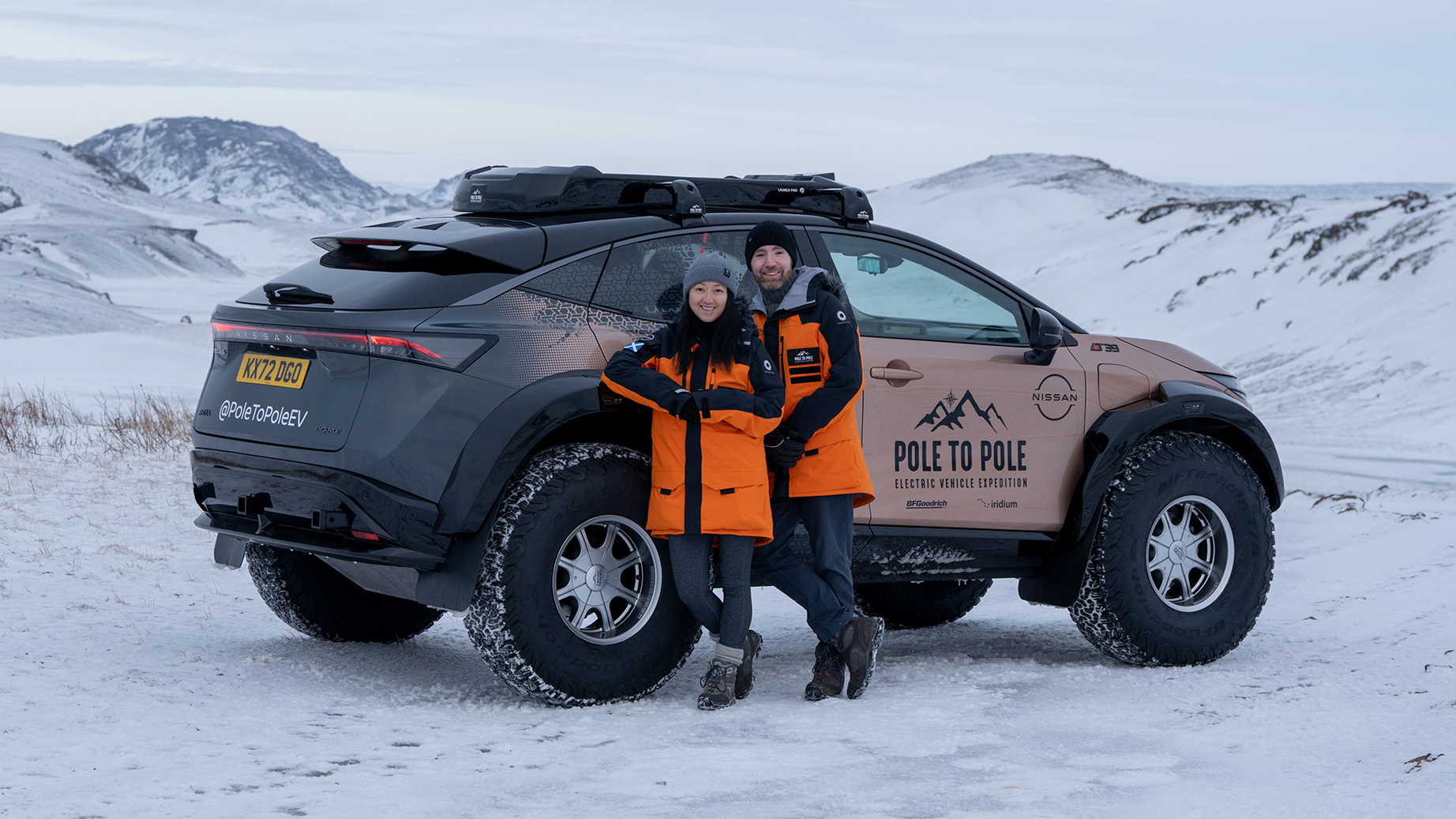09:40:52 am 12/18/2023
Viewed: 6762
The first-ever drive from the North to the South Pole in an all-electric Nissan Ariya.
Chris and Julie Ramsey piloted the vehicle, starting in March and finishing in December, covering a distance of 17,000 miles over nine months. Their journey aimed to demonstrate the viability of electric vehicles in extreme conditions. The Ariya, modified with large tires and minor adjustments, proved capable in various terrains and climates, even in the harsh Antarctic environment. The expedition also highlighted issues like limited charging infrastructure in South America and the impact of vehicle modifications on efficiency.
The success of the journey from the North to the South Pole in an all-electric Nissan Ariya was significant. The expedition covered 17,000 miles over nine months, demonstrating the vehicle's durability and performance in diverse and extreme conditions. Despite challenges like limited charging infrastructure and efficiency impacts due to vehicle modifications, the electric vehicle proved capable in various terrains, including the harsh Antarctic environment. This journey marks a milestone in showcasing the potential of electric vehicles in extreme settings.
Key modifications to the Nissan Ariya included:
Tires and Wheel Arches: The vehicle was fitted with 39-inch BF Goodrich tires, which are significantly larger than the standard tires. This necessitated modifications to the suspension and widening of the wheel arches to accommodate these larger tires. This adjustment was crucial for ensuring stability and support in various terrains, from glacial fields to desert dunes
All-Wheel Drive Technology: The Ariya was equipped with Nissan's advanced electric all-wheel drive system, e-4ORCE, which aids in navigating tough obstacles and challenging terrains
Charging Solutions: Given the challenge of limited charging infrastructure in remote areas, the team used a portable, renewable-energy unit mounted on a trailer, which included a wind turbine and solar panels. This setup enabled charging the Ariya’s battery pack during breaks. Additionally, depending on the weather, a 5kW wind turbine or a prototype solar hybrid charging solution was used. In some regions, such as the Arctic, they had to resort to a petrol generator as a backup
Additional Features for Comfort and Functionality: The Ariya was also equipped with an espresso machine for on-demand coffee during long isolated parts of the journey. A drone that could launch directly from the vehicle's roof was also included for documenting the journey
These modifications were strategically planned and executed to demonstrate the real-world capabilities of electric vehicles in extreme environments, while keeping changes to the core electric vehicle minimal. This aligns with the expedition's goal to showcase the viability of electric vehicles as a sustainable option in diverse and challenging conditions.
Overall, the Nissan Ariya's journey from the North to South Pole represents a significant milestone in demonstrating the potential and adaptability of electric vehicles in some of the most challenging environments on the planet.
https://www.youtube.com/watch?v=MwinwrItAXA
Chris and Julie Ramsey piloted the vehicle, starting in March and finishing in December, covering a distance of 17,000 miles over nine months. Their journey aimed to demonstrate the viability of electric vehicles in extreme conditions. The Ariya, modified with large tires and minor adjustments, proved capable in various terrains and climates, even in the harsh Antarctic environment. The expedition also highlighted issues like limited charging infrastructure in South America and the impact of vehicle modifications on efficiency.
The success of the journey from the North to the South Pole in an all-electric Nissan Ariya was significant. The expedition covered 17,000 miles over nine months, demonstrating the vehicle's durability and performance in diverse and extreme conditions. Despite challenges like limited charging infrastructure and efficiency impacts due to vehicle modifications, the electric vehicle proved capable in various terrains, including the harsh Antarctic environment. This journey marks a milestone in showcasing the potential of electric vehicles in extreme settings.
Key modifications to the Nissan Ariya included:
Tires and Wheel Arches: The vehicle was fitted with 39-inch BF Goodrich tires, which are significantly larger than the standard tires. This necessitated modifications to the suspension and widening of the wheel arches to accommodate these larger tires. This adjustment was crucial for ensuring stability and support in various terrains, from glacial fields to desert dunes
All-Wheel Drive Technology: The Ariya was equipped with Nissan's advanced electric all-wheel drive system, e-4ORCE, which aids in navigating tough obstacles and challenging terrains
Charging Solutions: Given the challenge of limited charging infrastructure in remote areas, the team used a portable, renewable-energy unit mounted on a trailer, which included a wind turbine and solar panels. This setup enabled charging the Ariya’s battery pack during breaks. Additionally, depending on the weather, a 5kW wind turbine or a prototype solar hybrid charging solution was used. In some regions, such as the Arctic, they had to resort to a petrol generator as a backup
Additional Features for Comfort and Functionality: The Ariya was also equipped with an espresso machine for on-demand coffee during long isolated parts of the journey. A drone that could launch directly from the vehicle's roof was also included for documenting the journey
These modifications were strategically planned and executed to demonstrate the real-world capabilities of electric vehicles in extreme environments, while keeping changes to the core electric vehicle minimal. This aligns with the expedition's goal to showcase the viability of electric vehicles as a sustainable option in diverse and challenging conditions.
Overall, the Nissan Ariya's journey from the North to South Pole represents a significant milestone in demonstrating the potential and adaptability of electric vehicles in some of the most challenging environments on the planet.
https://www.youtube.com/watch?v=MwinwrItAXA
No video exists.





Comments